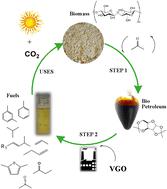当前位置:
X-MOL 学术
›
Sustain. Energy Fuels
›
论文详情
Our official English website, www.x-mol.net, welcomes your feedback! (Note: you will need to create a separate account there.)
From biomass to fuels: a carbon-efficient route combining ketalization and fluid catalytic cracking
Sustainable Energy & Fuels ( IF 5.6 ) Pub Date : 2024-02-21 , DOI: 10.1039/d4se00131a Juliana Carvalho 1 , Alessandra Vieira 1 , Alviclér Magalhães 1 , Leandro S. Mariz e Miranda 1 , Yiu Lau Lam 1 , Marcelo M. Pereira 1
Sustainable Energy & Fuels ( IF 5.6 ) Pub Date : 2024-02-21 , DOI: 10.1039/d4se00131a Juliana Carvalho 1 , Alessandra Vieira 1 , Alviclér Magalhães 1 , Leandro S. Mariz e Miranda 1 , Yiu Lau Lam 1 , Marcelo M. Pereira 1
Affiliation

|
One of the best ways to reduce the carbon footprint is to convert second-generation biomass (s-BM) into fuels in oil refineries. However, s-BM is not suitable for conventional processing. To circumvent this problem, we first converted s-BM under mild conditions in the presence of acetone into a stable non-corrosive liquid, which we call bio-petroleum (BP). This process did not result in carbon loss, and the BP exhibited a reduced number of parallel reactions during its further transformation. This article describes the results of co-processing BP with vacuum gasoil up to high amounts (75 wt%) through fluidized catalytic cracking (FCC). A small amount of unwanted coke was observed, while 70–79% green carbon was incorporated into products like LPG and gasoline. Feed mixtures up to 35 wt% BP produced drop-in fractions of green hydrocarbons to LPG, gasoline, and petrochemical feedstocks. With higher amounts of BP, the mixtures produced high added-value products. We employed this approach as a starting point to produce carbon-neutral fuels.
中文翻译:

从生物质到燃料:结合缩酮化和流化催化裂化的碳高效途径
减少碳足迹的最佳方法之一是将第二代生物质(s-BM)转化为炼油厂的燃料。然而,s-BM 不适合常规加工。为了解决这个问题,我们首先在丙酮存在的温和条件下将 s-BM 转化为稳定的非腐蚀性液体,我们称之为生物石油(BP)。这个过程没有导致碳损失,并且BP在进一步转化过程中表现出平行反应数量的减少。本文介绍了通过流化催化裂化 (FCC) 将BP与减压瓦斯油共加工至高含量 (75 wt%) 的结果。观察到少量不需要的焦炭,而 70-79% 的绿色碳被纳入液化石油气和汽油等产品中。BP含量高达 35 wt% 的进料混合物可将绿色碳氢化合物直接馏分转化为液化石油气、汽油和石化原料。BP含量较高时,混合物可产生高附加值产品。我们采用这种方法作为生产碳中性燃料的起点。
更新日期:2024-02-21
中文翻译:

从生物质到燃料:结合缩酮化和流化催化裂化的碳高效途径
减少碳足迹的最佳方法之一是将第二代生物质(s-BM)转化为炼油厂的燃料。然而,s-BM 不适合常规加工。为了解决这个问题,我们首先在丙酮存在的温和条件下将 s-BM 转化为稳定的非腐蚀性液体,我们称之为生物石油(BP)。这个过程没有导致碳损失,并且BP在进一步转化过程中表现出平行反应数量的减少。本文介绍了通过流化催化裂化 (FCC) 将BP与减压瓦斯油共加工至高含量 (75 wt%) 的结果。观察到少量不需要的焦炭,而 70-79% 的绿色碳被纳入液化石油气和汽油等产品中。BP含量高达 35 wt% 的进料混合物可将绿色碳氢化合物直接馏分转化为液化石油气、汽油和石化原料。BP含量较高时,混合物可产生高附加值产品。我们采用这种方法作为生产碳中性燃料的起点。



























 京公网安备 11010802027423号
京公网安备 11010802027423号